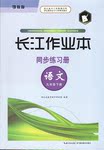题目内容
( )19.- -Where's Tom? --He's left a _______ saying that he has something to do.
A. excuse B. sentence C. news D. message
D

练习册系列答案
 长江作业本同步练习册系列答案
长江作业本同步练习册系列答案
相关题目
题目内容
( )19.- -Where's Tom? --He's left a _______ saying that he has something to do.
A. excuse B. sentence C. news D. message
D

 长江作业本同步练习册系列答案
长江作业本同步练习册系列答案